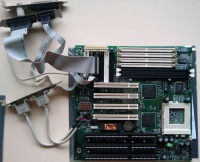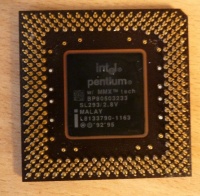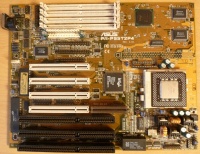Socket 7 Builds
Socket 7 platform offers late DOS and early Windows games compatibility. Almost anything from 1990 to 1998 can be played at reasonable framerate and with enough comfort.
Contents
Choosing a CPU
List of supported CPUs
- Intel Pentium (75-200MHz)
- Intel Pentium MMX (166-233MHz)
- AMD K5
- AMD K6 (sometimes K6-2 and K6-III)
- Cyrix 6x86
- idt WinChip, WinChip2
As you can see from the list above, there were plenty of CPUs for Socket 7 platform. However, the CPU of choice is usually either classic Pentium or Pentium MMX. They are better supported by chip set manufacturers (all most common chip sets were also produced by intel) and have good performance. AMD and Cyrix CPUs performance is subject of lots of arguments. WinChip processors were originally designed for low-cost market and though don't perform as well as Pentiums. They have more simple architecture and are closer to 486 and 5x86 rather than Pentium.
Pentium Classic
Classic Pentium CPUs have a wide variety of speeds, from 75 to 200 MHz. They are supported by literally any Socket 7 chip set and proved to be fine performers. Pentium Classic is a good choice for Socket 7 Build, especially for beginners. They are easy to find and cost next to nothing.
Benchmark information will follow shortly.
Pentium MMX
Pentium MMX CPUs arrived in 166, 200, 233MHz versions (66MHz x2.5, x3.0, x3.5).
Comparing to Pentium Classic, they have different core (P55C) with lesser 0.28 µm process. L1 cache was doubled (32KB vs 16KB). A new set of instructions called MultiMedia eXtensions was introduced, although the software to use them started to appear only by the time Pentium MMX processors were severely outdated.
Pentium MMX processors are supported by later Socket 7 motherboards with split rail voltage. Not every motherboard will accept such a CPU.
Overall Pentium MMX 233 can be considered the best choice of authentic CPU for a socket 7 system. When overclocked to 262MHz or further, it provides exceptional performance no other Socket 7 CPU can match. However, Super7 CPUs like K6-2 and K6-III still outperform Pentium MMX.
Pentium MMX CPUs are harder to find than classic Pentiums, but they are still quite cheap.
Overclocking
Disclaimer: Author does not take any responsibility for any damage caused by you in the course of overclocking.
Pentium MMX are known to work fine over clock. For that purpose 233MHz version should be used, as most 166 and 200MHz versions have locked multipliers. On a solid motherboard most Pentium MMX can work fine on bus speeds 60, 66, 75 or even 83 MHz (see table). However, RAM and PCI bus might not cope with 83 MHz FSB.
| FSB | x2.5 | x3.0 | x3.5 |
|---|---|---|---|
| 60MHz | 150MHz | 180MHz | 210MHz |
| 66MHz | 166MHz | 200MHz | 233MHz |
| 75MHz | 188MHz | 225MHz | 262MHz |
| 83MHz | 207MHz | 250MHz | 291MHz |
Benchmark information will follow shortly.
Cyrix 6x86
AMD K5
AMD K6
AMD K6-2 and K6-III
Choosing a chip set
Intel released several chipsets for Socket 7. Compared to the earlier Pentium chipsets these were more reliable and feature packed. The first chipset released by Intel for socket 7 was the 430FX in 1995, codename Triton I. It introduced a new Southbridge chip called PCI IDE ISA Xcelerator - PIIX that included the functionality of several common I/O interfaces, including a PCI to ISA bridge and an integrated Dual Channel IDE controller. The 430FX chipset caches up to 64 MB DRAM and supports PCI 2.0. For later Pentiums 430FX based boards usually require a separate voltage regulator plugged.
In 1996 the Triton II chipset 430HX followed. It was targeted for professional users, supported tighter memory timings, SMP and is able to cache up to 512 MB. This usually requires a Tag-RAM upgrade. It features an updated PIIX3 southbridge, that has PCI 2.1, USB 1.0, Busmaster DMA support for IDE transfers and independend IDE drive timings. Due to the lack of USB devices at this time board manufacturer often left the USB connector unsoldered. The Consumer version of the Triton II chipset was introduced at the same time and called 430VX. While it also used the PIIX3 southbridge, it did not support SMP and could only cache up to 64 MB. The main difference is the support for SDRAM.
Finally in 1997 Intel released its last chipset for the socket 7 platform, the 430TX. The chipset was consumer oriented and supported FPM/EDO/SDRAM while still keeping the cacheable area at max. 64 MB. The southbridge got replaced by PIIX4 that added ACPI and UDMA/33.
Overall all Intel chipsets are easy to setup and supported directly by Windows98 up to Windows XP. Later chipsets offer better performance on average due to increased internal buffers. If more than 64 MB should be equipped the 430HX chipset sticks out as the only option where the RAM is covered by the L2 cache. The speed gain from using SDRAM compared to EDO is in the range of a few percent, same goes for the upgrade from 256 kB pipelined burst cache to 512 kB by using a COAST module. As Intel left the Socket 7 platform with Pentium 233 MMX all chipsets support a FSB of 66 MHz maximum. Board manufacturers often offered higher multipliers for CPUs that allow to use faster CPUs like a AMD K6 on these chipsets. Of course higher power consumption of faster CPUs should be considered, since a lot of boards with Intel chipsets use simple linear voltage regulators.



